- News
- Reviews
- Bikes
- Components
- Bar tape & grips
- Bottom brackets
- Brake & gear cables
- Brake & STI levers
- Brake pads & spares
- Brakes
- Cassettes & freewheels
- Chains
- Chainsets & chainrings
- Derailleurs - front
- Derailleurs - rear
- Forks
- Gear levers & shifters
- Groupsets
- Handlebars & extensions
- Headsets
- Hubs
- Inner tubes
- Pedals
- Quick releases & skewers
- Saddles
- Seatposts
- Stems
- Wheels
- Tyres
- Tubeless valves
- Accessories
- Accessories - misc
- Computer mounts
- Bags
- Bar ends
- Bike bags & cases
- Bottle cages
- Bottles
- Cameras
- Car racks
- Child seats
- Computers
- Glasses
- GPS units
- Helmets
- Lights - front
- Lights - rear
- Lights - sets
- Locks
- Mirrors
- Mudguards
- Racks
- Pumps & CO2 inflators
- Puncture kits
- Reflectives
- Smart watches
- Stands and racks
- Trailers
- Clothing
- Health, fitness and nutrition
- Tools and workshop
- Miscellaneous
- Buyers Guides
- Features
- Forum
- Recommends
- Podcast
review
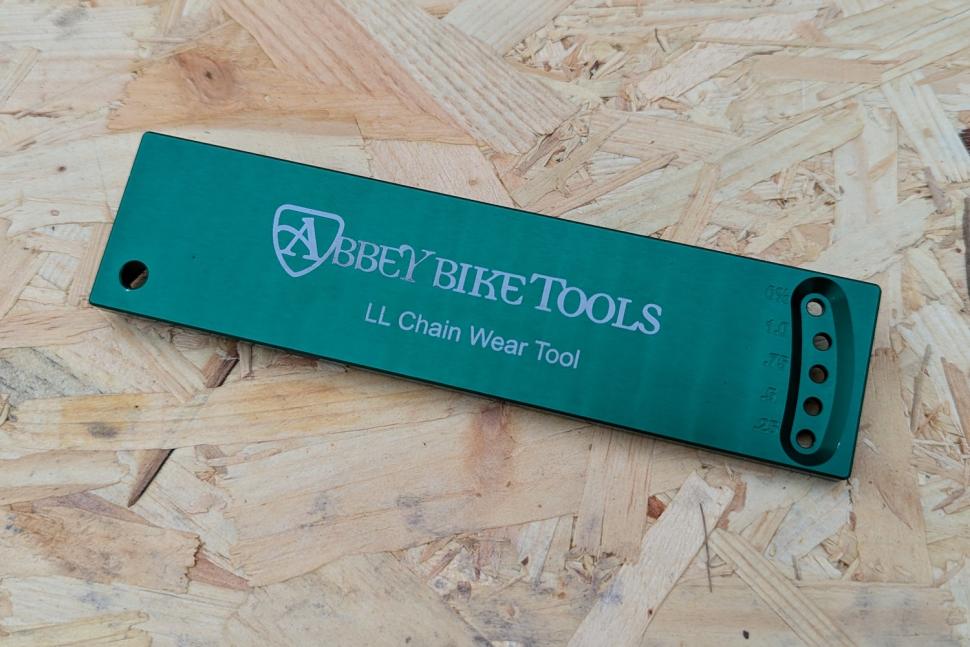 2025 Abbey Bike Tools LL Chain Wear Tool Hero.jpg
2025 Abbey Bike Tools LL Chain Wear Tool Hero.jpg£49.00
VERDICT:
Excellent chain wear tool that is easy to use and accurate
Measures length and lateral wear
Works on all drivetrains, including SRAM Flattop chains
Easy to use
Expensive for a chunk of aluminium
Weight:
126g
Contact:
At road.cc every product is thoroughly tested for as long as it takes to get a proper insight into how well it works. Our reviewers are experienced cyclists that we trust to be objective. While we strive to ensure that opinions expressed are backed up by facts, reviews are by their nature an informed opinion, not a definitive verdict. We don't intentionally try to break anything (except locks) but we do try to look for weak points in any design. The overall score is not just an average of the other scores: it reflects both a product's function and value – with value determined by how a product compares with items of similar spec, quality, and price.
What the road.cc scores meanGood scores are more common than bad, because fortunately good products are more common than bad.
- Exceptional
- Excellent
- Very Good
- Good
- Quite good
- Average
- Not so good
- Poor
- Bad
- Appalling
The Abbey Bike Tools LL Chain Wear Tool goes beyond standard chain measuring by assessing both linear and lateral wear. Crafted from a chunky block of aluminium, it offers exceptional accuracy and durability, it's simple to use, and it's compatible with all chains, including the latest SRAM 12-speed Flattop models.
> Buy now: Abbey Bike Tools LL Chain Wear Tool for £49 from Saddleback
The "LL" in the name stands for Lateral and Linear. Linear wear is the typical measurement taken, indicating chain stretch. The tool's lateral section measures the sideways movement within the chain rollers. Unlike linear stretch, which has an accepted replacement threshold depending on the chain's speed, lateral wear lacks a universally defined standard. Abbey Tools has placed markings from 1 to 9, with a suggested replacement point at 6.
The tool is compatible with all current chain standards, including SRAM's Flattop chains. These chains feature rollers that are 0.254mm (0.010in) larger in diameter than most, which can pose issues for other chain wear tools. While this difference might seem minor, Abbey points out that, over five links, it translates to a 0.2% variation – enough to determine whether only the chain needs replacing or the entire drivetrain.
> Do you need a new chain? Read our feature on the easy way to tell...
Precision-engineered from a single block of aluminium, the tool is robust and accurate, with clear markings cut into the aluminium and not simply part of the anodised finish. Abbey opted for CNC machining over the more common laser-cut approach, stating that it gives increased accuracy and repeatability to the manufacturing process.
The linear section can be used with the chain on or off the bike, but I've found it easiest with the chain mounted. At the rear of the tool, a V-shaped notch fits securely onto a roller, isolating its movement and ensuring compatibility with chains of various sizes. To measure stretch, align the tool with the chain rollers and observe which of the five holes aligns with the centre of a roller. This straightforward process provides a stretch reading between 0% and 1.0% in 0.25% increments. While the tool offers five fixed measurement points, it's also possible to estimate wear between two points. For example, with many 12-speed chains, where the recommended replacement threshold is 0.5% wear, you can gauge the wear between 0.25% and 0.5%.
The reverse side of the tool measures lateral play, with clear, easy-to-follow instructions provided. As lateral wear measurement is unique to this tool, it's helpful not to need a manual or online guidance every time.
To use this feature, the chain must be removed, which won't be ideal for everyone, particularly since many modern chains with quick-links have a limited number of reuses. The lateral measurement reflects the roller's play; while excessive movement doesn't necessarily indicate wear in the traditional sense, it can impact shifting performance.
Built to last, the tool's aluminium construction ensures durability. And while the anodised markings might fade over time, the most important wear markers are etched directly into the aluminium, ensuring they will always be possible to read.
Looking to do your own bike fettling? Check out our feature on the six essential tools for cyclists who do their own bike maintenance, as well as our beginner's guide to bike tools.
Over the past year, I've become increasingly mindful of monitoring chain wear, particularly with multiple bikes to manage. I also favour chain waxing and use a rotation system for convenience. Previously I have relied on multiple tools to cross-check for accuracy. My go-to was the Pedro's Chain Checker Plus II, which isolates pin wear from roller wear with three-point contact. However, it lacks guidance on the required force, potentially leading to inconsistent results. The Park Tool CC-2 chain checker offers readings across the full range (0% to 1%), but its small pins are prone to bending, leading to inaccuracies, and it is also incompatible with SRAM 12-speed chains.
The Wippermann Connex chain wear tool is simple to use but only supports chains with a 7.75mm roller diameter, ruling out SRAM Flattop chains. It also pushes rollers in opposite directions, failing to isolate roller wear from pin wear.
As far as I'm aware, no other tool currently measures lateral wear, it's a feature unique to the Abbey LL Chain Wear Tool. And while I haven't found a chain that exceeds Abbey's recommended replacement point, this might simply be because of the chains I have and their wear levels. I have still chosen to use the tool and check the measurement each time I re-wax a chain, and if you're looking to maximise shifting performance, it could become an important measurement.
Value and conclusion
The Abbey Bike Tools LL Chain Wear Tool costs £49, which may seem steep for a block of aluminium – Pedro's Chain Checker Plus II is £19.99, and Park Tool's CC-4.2 and CC-2 are £17.99 and £29.99 respectively. Some might argue that a simple ruler can suffice, but while that's technically true, it lacks accuracy, consistency and the ability to assess roller wear, and no other tool offers the unique lateral wear measurement provided by the LL tool.
Though it's an investment, it becomes easier to justify when you consider the rising costs of chains and drivetrains. For example, SRAM's XXSL T-Type chain is an eye-watering £160, with cassettes from major manufacturers often exceeding £200. The tool could quickly pay for itself by helping to extend the life of these components.
In my experience, while the lateral wear measurement feels more like a bonus than an essential feature, the tool truly excels in its ability to measure chain wear accurately and consistently. Its compatibility with all chains, ease of use, and durable construction make it the tool that I will reach for every time, and trust enough that I won't feel the need to cross-check it against others. It could also be perfect for professional mechanics who might need to use it daily.
> Buy now: Abbey Bike Tools LL Chain Wear Tool for £49 from Saddleback
Verdict
Excellent chain wear tool that is easy to use and accurate
road.cc test report
Make and model: Abbey Bike Tools LL Chain Wear Tool
Size tested: n/a
Tell us what the product is for and who it's aimed at. What do the manufacturers say about it?
Abbey Bike Tools says:
Chain wear has become a little more complicated ever since 1x drivetrains have gained popularity. These drivetrains are designed to cross chain, something most of us were taught to avoid when we started riding bikes as a serious endeavor. Add to that the variables that flat top chains have brought into the market with their larger rollers and things got pretty messy. Problem is, everyone is ignoring these small but significant issues.
What are the issues with measuring chain wear? Well there's a couple of them, the biggest is the diameter difference of SRAM's flat top chains found on most of their modern drivetrains. The rollers on these chains are .010" (.254mm). Now that doesn't sound like a lot but when you do the math to convert that to a percentage of wear over 5 links that's a .2% difference. When we're replacing chains between .5-.7% of wear that .2% can easily be the difference between replacing just a chain and and entire drivetrain. But wait, there's MORE! Most chain wear tools currently on the market are laser cut metal. This is a pretty cool process that's great for making sheet metal parts, problem is the accuracy of this process isn't great at +/-.010" (.254mm). If you add the error of the tool itself to the roller variable it's possible to double the error of the tool.
The Abbey Chain Wear Plate is our latest application of precision to cycling tools. We set out to not only build a tool that handled the variance of roller diameter when measuring chain wear but also measure lateral wear, something nobody's bothered to do, until now. Linear wear or stretch as it's commonly called is measured by locating both sides of the roller in a V shaped notch which allows us to locate the center of the roller accurately regardless of it's size. Then you line up the pin on with one of 5 holes on the opposite end. This also prevents roller wear from influencing the measurement. It's as simple as that.
To measure lateral wear, the chain will need to be off the bike. Then simply pinch the chain against the boss and hold it vertical and see how far it sags. Anything below a 6 isn't shifting well and a new chain will improve shifting quality.
The other big thing we tackled with this tool is the accuracy of the tool itself. Most chain wear tools on the market are cut with a laser, which is a nice process that we use for parts like our Fit Kit and Stu Stick. However it's not all that accurate with the repeatability of these machines can be around +/-.010. That just isn't good enough for tools of this nature to be frank. We instead made the decision to CNC our tool from a billet to give it the durability and accuracy this tool deserves. Since we actually make these in house we also had complete control over the process and are able to hold tolerances as tight as .0002"(.005mm). Admittedly, that might be a bit overkill for the application but it's not really that difficult to do, if you actually care.
Tell us some more about the technical aspects of the product
- Compatible with all chains, including SRAM Flat Top models.
- Measures linear and lateral stretch
- CNC cut for precision and repeatable accuracy with machine accuracy to .005mm (0002")
Rate the product for quality:
10/10
Rate the product for performance:
9/10
Rate the product for value:
6/10
Tell us how the product performed overall when used for its designed purpose
Durable and easy to use, with clear directions marked on the tool. The linear wear measurement in particular is excellent, and it is compatible on all chain types.
Tell us what you particularly liked about the product
Very simple to use, especially the length wear.
Tell us what you particularly disliked about the product
Although not a dislike, to use the lateral wear element you do need to remove the chain and this may not be something some riders do on a regular basis.
How does the price compare to that of similar products in the market, including ones recently tested on road.cc?
It's pricey (but worth it). The Birzman Chain Wear Indicator II is £26.99, Pedro's Chain Checker Plus II is £19.99, and Park Tool's CC-4.2 and CC-2 are £17.99 and £29.99 respectively.
There are much cheaper tools, such as the Torque Chain Tool at just £5.99, although it's only compatible on some chains.
Did you enjoy using the product? Yes
Would you consider buying the product? Yes. I have multiple chain wear tools, but this is the best.
Would you recommend the product to a friend? Yes
Use this box to explain your overall score
It's excellent. It's robust and easy to use and provides a measurement that I have found repeatable. It works on all chains, including SRAM Flattop 12-speed types, and is built to last. It is expensive but probably the last and only chain wear tool you will need.
About the tester
Age: 39
I usually ride: My best bike is: Cannondale SystemSix
I've been riding for: Over 20 years I ride: Every day I would class myself as: Expert
I regularly do the following types of riding: road racing, cyclo cross, commuting, sportives, general fitness riding, fixed/singlespeed, mtb, Lots of gravel style riding
Matt is an endurance nut who loves big rides and big events. He's a former full-time racer and 24hr event specialist, but now is also happy riding on or off-road and loves long adventures and audax events.
Latest Comments
- David9694 1 sec ago
Down my way, a 200 yard bus gate or 20 mph limit extinguishes all economic and domestic life, so I assume Paris centre-ville has been rendered a...
- Miller 50 min 7 sec ago
Thanks. I have no idea about the bike which is being held at a local police station. I can't imagine it's in good shape. I remember nothing about...
- TimC340 1 hour 2 min ago
Why didn't RoadCC have a review sample before this article? Then it would be less speculation and more fact. Never mind, DCRainmaker and DesFit...
- mark1a 4 hours 53 min ago
I think the best thing I did when I rode the sportive in 2016 (163km edition from Busigny with all 29 cobbled secteurs) was to fit Elite Pria Pavé...
- mark1a 5 hours 13 min ago
On the plus side, I haven't taken out any over 50 life insurance plans or felt compelled to arrange any prepaid funerals over the weekend, or...
- chrisonabike 7 hours 3 min ago
Edinburgh has formal booking, they added putting "bike" or "cargo bike" in the car registration section. (I've just checked again and oddly you...
- ktache 7 hours 23 min ago
I don't think I will be converting anytime soon, but thanks for the report, and I wouldn't mind if you update with real world use.
- Freddy56 8 hours 8 min ago
I would say it more a jersey than a jacket. Super warm chest insulated with the sleeves are lighter, more like a roubaix top, so, ideal spring wear...
- PenLaw 8 hours 26 min ago
Nigel Farage is simply pleasing his main sponsors, that being big oil and their Telegraph/Express pseudo employees....
- Rendel Harris 9 hours 18 min ago
I don't know if they would specifically target them but I do know that travelling on local services around London a couple of times a week, once or...









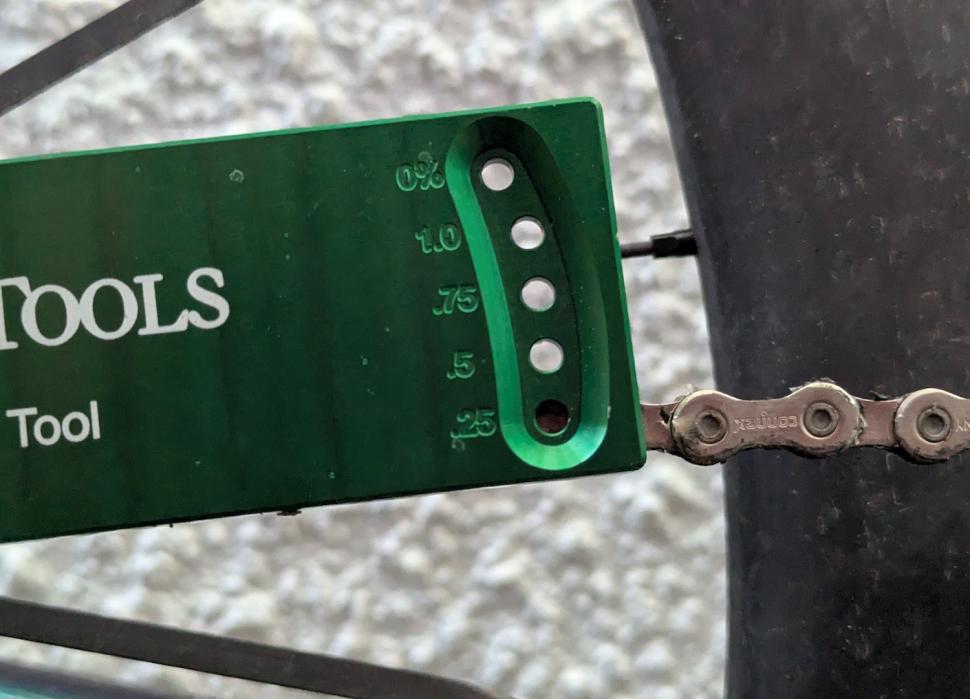
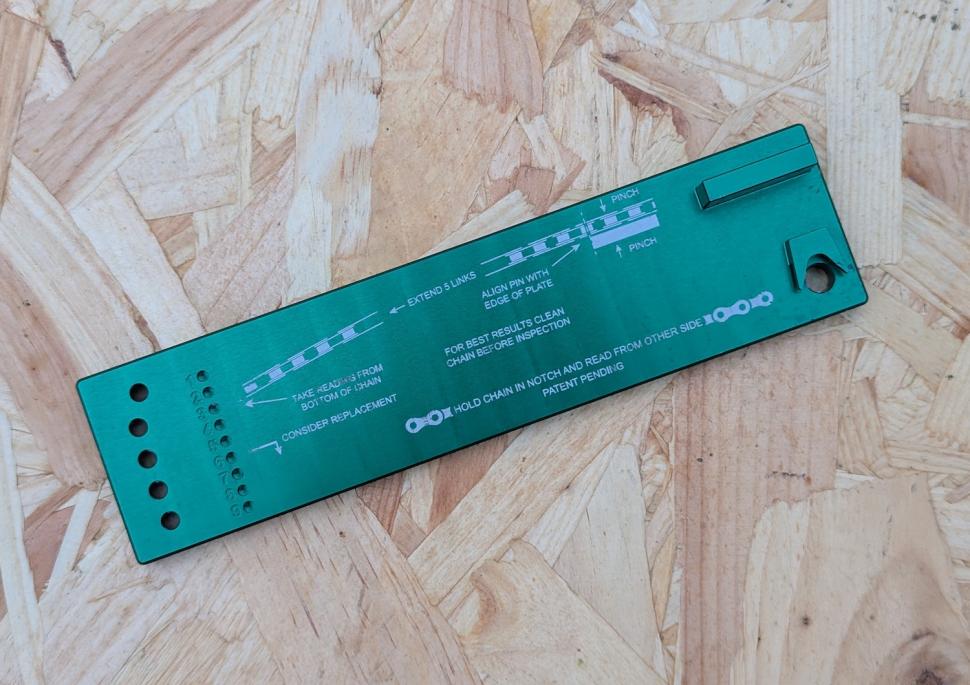


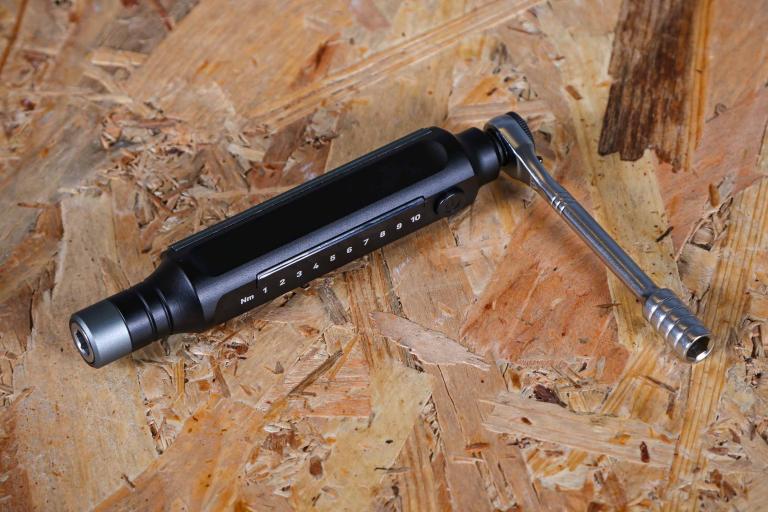
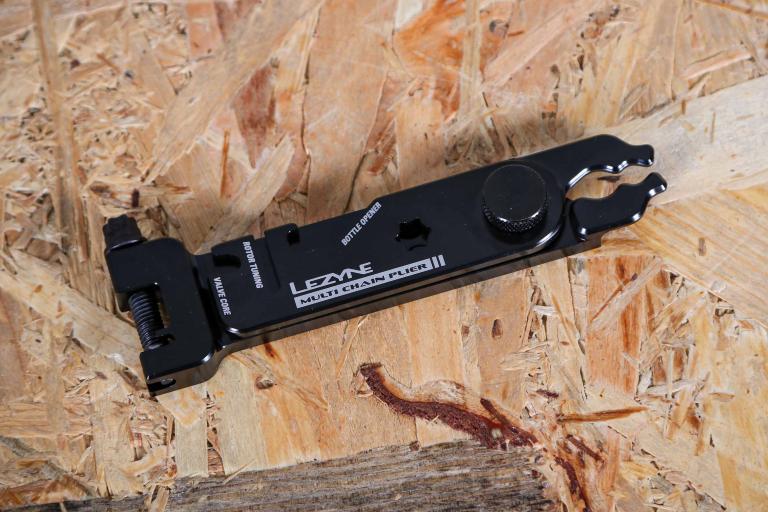
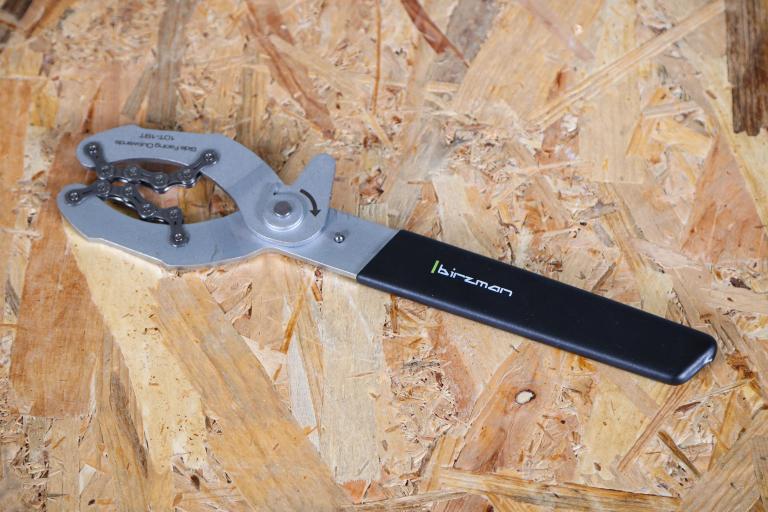
Add new comment
5 comments
If you are unable to use a ruler or a rule to measure a chain then purchase this nice toy 👍 If you can actually measure things it's pretty but pointless.
To measure chain wear with a ruler you have to be able to measure so precisely that you can tell the difference, measuring from the exact centre of one rivet to the exact centre of one twenty-four rivets away, between 304.8mm (new) and 306.3mm (needs replacing). If you're 0.5mm (0.16%) out either way you could bin a chain that doesn't need replacing or carry on with one that does. Anyone who claims they can measure a bike chain in situ with a ruler to that accuracy is either superhuman or a gobshite.
If you have an inch ruler its easier, because 24 rivets should be exactly 12 inches.
And you need only measure from the side of a rivet to the side of another rivet, or the end of a chain plate to the end of another chain plate.
It's dead easy with a good steel ruler.
I know, but you still have to be able to measure to within 1/16 of an inch (1.5mm) and given that it's an either way measurement you have to be accurate to within 1/32 of an inch (0.75mm) to know if a chain needs replacing or not and nobody's eyes - or rulers - are that precise, let alone their ability to ensure the chain is perfectly straight along their rule. I don't know any competent mechanic who would say that a ruler is a useful way of checking chain wear. You don't need an expensive tool like this but a basic drop-in chain wear gauge is far more accurate an indicator of wear than any ruler.
I am not sold on this - As mentioned, Sram has ok'd e.g. Pedro's chain checker which is more like a traditional tool. And those you can fit and get a measure in without having to either scroutch down or lift the bike to get a measurement. Also, I think slightly dirty chains will be easier to measure with a more traditional style tool as well. The lateral measurement indicator is interesting but I think that this wear goes so strongly hand-in-hand with longitudal wear, that it does not really bring anything essential to the table.